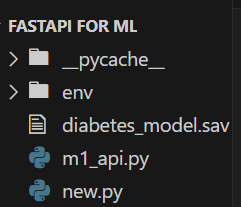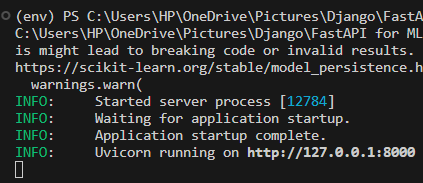
|
|
In this article, we will delve into the process of deploying diabetes prediction models using FastAPI, an acronym for “Application Programming Interface.” FastAPI enables us to predict the likelihood of diabetes in any individual with remarkable precision and efficiency. After developing and setting up this API, the subsequent crucial step involves seamlessly integrating it with our user interface (UI) model, thus empowering us to make accurate and swift diabetes predictions for enhanced healthcare decision-making. Deploy Diabetes Prediction model as FastAPIBelow are the steps by which we can deploy the diabetes prediction model as FastAPI in Python: Step 1: Install the Necessary LibrariesWe need to install a set of essential libraries to create the FastAPI-based diabetes prediction model. Here’s a step-by-step guide to ensure you have the required tools in your environment: In building a FastAPI for machine learning models, we rely on several key libraries. FastAPI, serves as the core framework for creating web services, while “uvicorn” efficiently handles HTTP requests for the FastAPI application. The “scikit-learn” library empowers the development of predictive models and data preprocessing, while “requests” facilitates interaction with the FastAPI through HTTP requests. Additionally, “pypi-json,” though less common, can prove useful for handling JSON data exchanged between the API and clients. These libraries collectively lay the foundation for a robust FastAPI that seamlessly integrates with machine learning models. pip install fastapi By following these steps, you’ll set up the necessary environment and tools to create a FastAPI-based API for diabetes prediction. This API can be integrated into your user interface, allowing you to predict the likelihood of diabetes in individuals with ease. Step 2: Download CSV FileFirst download the diabetes.prediction.sav file. Step 3: Create Virtual EnvironmentFirst create the virtual environment which is should be our first step to start to create any project and then enter in virtual environment Step 4: File structureBelow is the required file folder format that we have to make to make our project.  File Structure Step 5: Write FastAPI Code (m1_app.py)Import Necessary Libraries:
Create a FastAPI App:
Define a Pydantic Model:
Load a Pre-trained Machine Learning Model:
Define a POST Endpoint for Diabetes Prediction:
Python3
after write the code run the command uvicorn m1_app:app
Then your API is successfully generated for check the API is generated or not create a new file  FastAPI run successfully Step 6: Write Python File (new.py)In this step, we are writing our code that will be used to receive the response and also to convert our input format to required json format. new.py
After writing the code put the values of the parameter according to dataset and simply run the file then you can get your result the person is diabetic or not . Python3
Output : "The Person is Diabetic" or "The Person is not Diabetic"
its gives output according to the input values. Video DemonstrationConclusion In this article, we explored the process of creating a diabetes prediction FastAPI. With the integration of this API into any web application, we can establish an efficient and reliable diabetes prediction system. This system enables us to quickly determine whether a person is diabetic or not through a few simple steps. This API proves to be highly valuable in enhancing the accuracy and user-friendliness of our prediction models. Furthermore, leveraging the same FastAPI approach for diabetes prediction, we can easily extend our capabilities to create prediction APIs for other domains. All it takes is generating a sav file for the specific model and utilizing that sav file to develop an API for that particular model.. |
Reffered: https://www.geeksforgeeks.org
| Python |
Type: | Geek |
Category: | Coding |
Sub Category: | Tutorial |
Uploaded by: | Admin |
Views: | 16 |